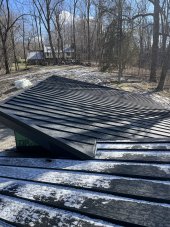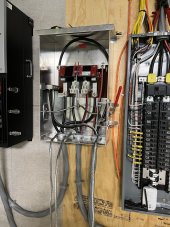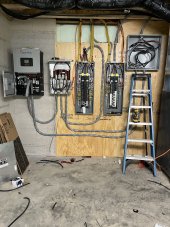hautions11
New Member
Hi Everyone, Building a new house and I would like to get a good baseline for a battery/solar house. Since the electricians are here in a few weeks, I want to install the basics right up front, designed around a Sol-Ark 15k. I have read a lot of comments on overwhelming the Sol-Ark running a 200 amp panel, so I am trying to avoid that.
I am on the grid and the basic goal is to minimize dependency on the grid and get some grid down security.
I am starting with a 320 amp service. My thought is a 200 amp main box powered by the Sol-Ark. I will put a variety of large loads in the second 120 amp panel. In the 120 amp panel are; EV charger, 220 circuite for table saw, planer shop tools, emergency power strip for geothermal, dryer, mini-split (porch/garage) and electric oven. My idea is to try eliminate non essential big loads off the main 200 amp panel.
Eventually I want a 6-8 KW solar array, but not in the initial install. I am thinking DC input from the solar. The house is tight with Spray foam and an ICF walk out foundation.
My big loads on the 200 amp panel; 3 ton geothermal pulling 2.3 KWH, heat pump hot water heater, ( geothermal heats water all summer while in AC mode), cook top,( oven on non-essential panel)
So, I was looking for some thoughts on up front ideas that I should not miss to make sure I incorporate the key items and features.
I am debating on wiring in a small inverter generator for any Mutiple day power outages. I have seen a lot of discussion on using the GEN function for other functions.
Fire away, i am open to any input.
I am on the grid and the basic goal is to minimize dependency on the grid and get some grid down security.
I am starting with a 320 amp service. My thought is a 200 amp main box powered by the Sol-Ark. I will put a variety of large loads in the second 120 amp panel. In the 120 amp panel are; EV charger, 220 circuite for table saw, planer shop tools, emergency power strip for geothermal, dryer, mini-split (porch/garage) and electric oven. My idea is to try eliminate non essential big loads off the main 200 amp panel.
Eventually I want a 6-8 KW solar array, but not in the initial install. I am thinking DC input from the solar. The house is tight with Spray foam and an ICF walk out foundation.
My big loads on the 200 amp panel; 3 ton geothermal pulling 2.3 KWH, heat pump hot water heater, ( geothermal heats water all summer while in AC mode), cook top,( oven on non-essential panel)
So, I was looking for some thoughts on up front ideas that I should not miss to make sure I incorporate the key items and features.
I am debating on wiring in a small inverter generator for any Mutiple day power outages. I have seen a lot of discussion on using the GEN function for other functions.
Fire away, i am open to any input.






